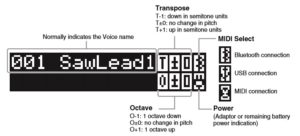The Yamaha SHS-500 Sonogenic keytar won a Winter NAMM 2019 Best In Show “Gotta Stock It” award. Congrats!
The for-real (PDF) Yamaha SHS-500 Owner’s Manual and Reference Manual are available on Yamaha’s Web site. Yamaha just published text manuals at launch. Now that I can see pictures (!), there’s a few things worth mentioning.
The SHS-500 does not have a 5-pin DIN MIDI connector. It has a multi-pin MIDI terminal to which you connect a MIDI breakout cable — just like Reface. So, the SHS-500 supports both 5-pin MIDI IN and MIDI OUT.
Side comment: I hope the MIDI manufacturers do not butcher MIDI 2.0 with ridiculous complexity. I like 5-pin MIDI because of its simplicity, both messages and electrical signaling. MIDI over USB, to me as a hardware/software developer, is a nightmare.
The SHS-500 has both headphone out and LINE out. The LINE out is 1/4″ mono. Plugging into the LINE out does not silence the internal speaker. The volume knob does not change the LINE out level.
In the nerd humor department. The Reference Manual recommends “Use audio cables and adapter plugs having no (zero) resistance.” Get out your superconductors.
The display format is clear and simple once you see an explanation of the icons (shown below). [Click images to enlarge.]
The keytar neck puts numerous controls under the hand:
- OCTAVE buttons INC and DEC
- TRANSPOSE buttons INC and DEC
- SONG CONTROL: Fast reverse, Play/pause, Fast forward
- JAM button (enables JAM function)
- SUSTAIN button
- PITCH BEND wheel
- MODULATION wheel
- FUNCTION button
I don’t see any lefties playing the SHS-500 like Hendrix, i.e., left-handed and upside-down. If you’re a Yamaha PSR person, you know that the FUNCTION button is your gateway to MIDI settings, etc. Some of the other things you can change are the tuning, EQ type, pitch bend range, portamento (ON/OFF and time), DSP type, MIDI port (Bluetooth, USB, wired), MIDI channel, local control ON/FF, audio loop back, battery type and auto OFF.
Although there is an EFFECT CONTROL knob for adjusting the currently selected DSP effect, effect control can be assigned to the MODULATION wheel. Just one of those things that you can change using the FUNCTION button. EFFECT CONTROL aside, the MODULATION wheel is assigned to Vibrato Depth. No other options.
The MIDI connection diagram shows that Yamaha is thinking ahead to Android support.
The specifications describe the keyboard as “37 HQ (High Quality) Mini Keys.” They must be using the Reface key bed.
The SHS-500 can send audio over USB to a receiving computer/device. Funny, the $5,000+ Genos still cannot do this.
There is no voice editing per se other than effect control. You can control the filter (cutoff and resonance) and keyboard dynamics (touch sensitivity). The SHS-500 appears to have a three stage effects chain: Reverb, chorus and DSP. You can control only the reverb and chorus depth, not type.
There are nine DSP effect types: Distortion 1, Distortion 2, DSP chorus, Flanger, Phaser, Tremolo, Rotary speaker, Low pass filter and high pass filter. Each effect type has one type-specific parameter under user control.
I can make a practical case of the Sonogenic even if I never prance and jeté with it. The SHS-500 is like a polyphonic, sample-playback Reface. I play a Yamaha Reface YC at rehearsals and often wish for other voices like flute or strings. The Sonogenic would be excellent as a very light-weight rehearsal instrument — something that’s easy to throw into the car.
Interested? Then check out these postsl about the Sonogenic:
The Yamaha SHS-500 Sonogenic is based on the Yamaha VKB-100 Vocaloid™ keyboard:
Copyright © 2019 Paul J. Drongowski

